Tried and True Armory ATrim XIIIa.1
Jul 19, 2011 5:02:41 GMT
Post by MuerteBlack on Jul 19, 2011 5:02:41 GMT
Tried and True Armory ATrim XIIIa.1 Review
By Walter Robins
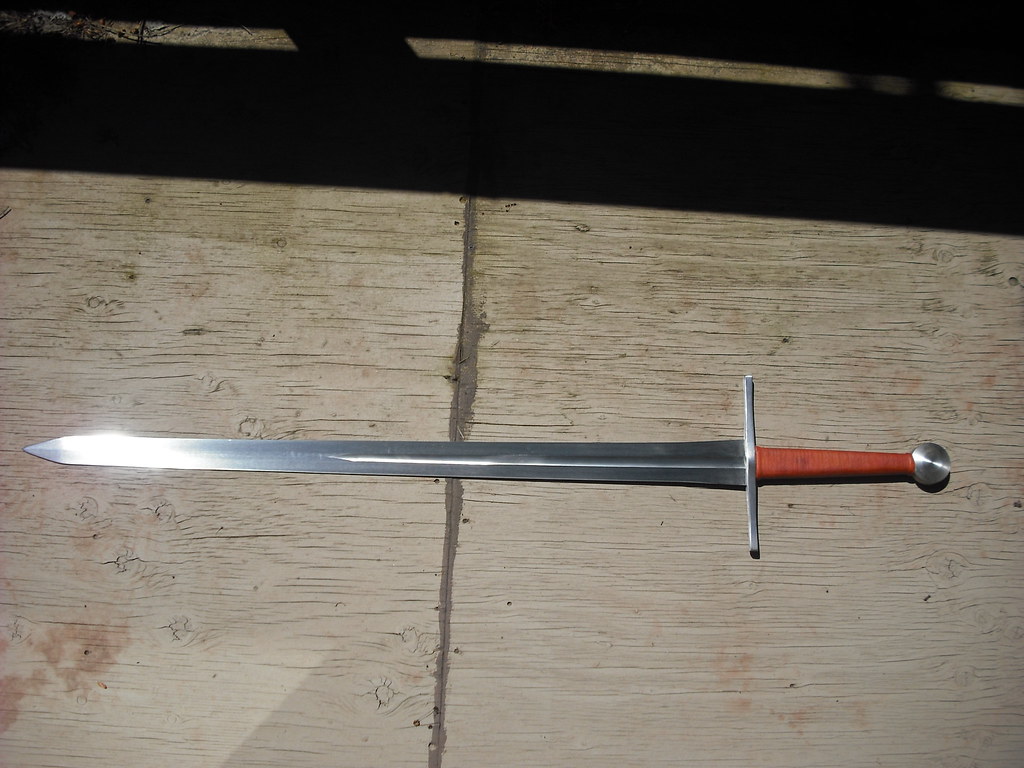
Introduction
Wow, where do I begin…
A couple weeks ago I was just minding my own business when I suddenly received notification of a PM in my inbox. It was Tom, asking me if I would review and cut with a new sword that Angus Trim had just sent over for Tried and True Armory. After carefully considering the offer for all of 0.00000001 seconds, I decided to take him up on it.
Ok, I know I’m not fooling anyone. I was absolutely jumping up and down with the excitement of getting to handle an ATrim in person. I had only seen pictures and videos of Gus’ swords, wishing I could pick one up. But now, I finally got the chance. I don’t know what prompted Tom to pick me of all people, since I haven’t been terribly active lately in either the forum or my own website, but I’m sure not going to complain about an opportunity like this!
Historical overview
This sword classifies as an Oakeshott type XIIIa. The type XIII swords are similar to the more classically represented type XII swords, but exhibit far less profile taper (thus an overall broader blade) and a more rounded tip, favoring the cut, whereas the type XII seeks a balance between cutting and thrusting. In relation to the plain vanilla type, the XIIIa is similar to the XIIa in that it sports a larger blade and a longer handle than the type XIII, allowing for comfortable two-handed use.
If I had to guess on the fittings based on my limited knowledge of fittings typology, I would say the crossguard is a style 1, while the pommel appears to be a type I.
Full Disclosure
I do not actually own this sword, and thus did not pay anything for it. It was sent to me by Tom on behalf of Tried and True Armory for review. It was thus essentially a free review sword. However, after having met Tom and Gus in person, I feel strongly that they are upstanding individuals who would want me to call it like it is and not to pull any punches in the review; so I will do just so.
It should also be noted here that although I was offered this sword to review, I am not receiving any compensation or free products to keep as a result of this review, so I have no financial incentives to be biased in any given direction. I do, however, have every reason to pursue respect and trustworthiness in the sword community, and so I will definitely do my best to be impartial here.
Initial Impressions
This sword came packed in a simple cardboard sheath. While thin, it did not show any signs of damage during shipping. After quickly removing the cardboard, I was presented with the sword itself.
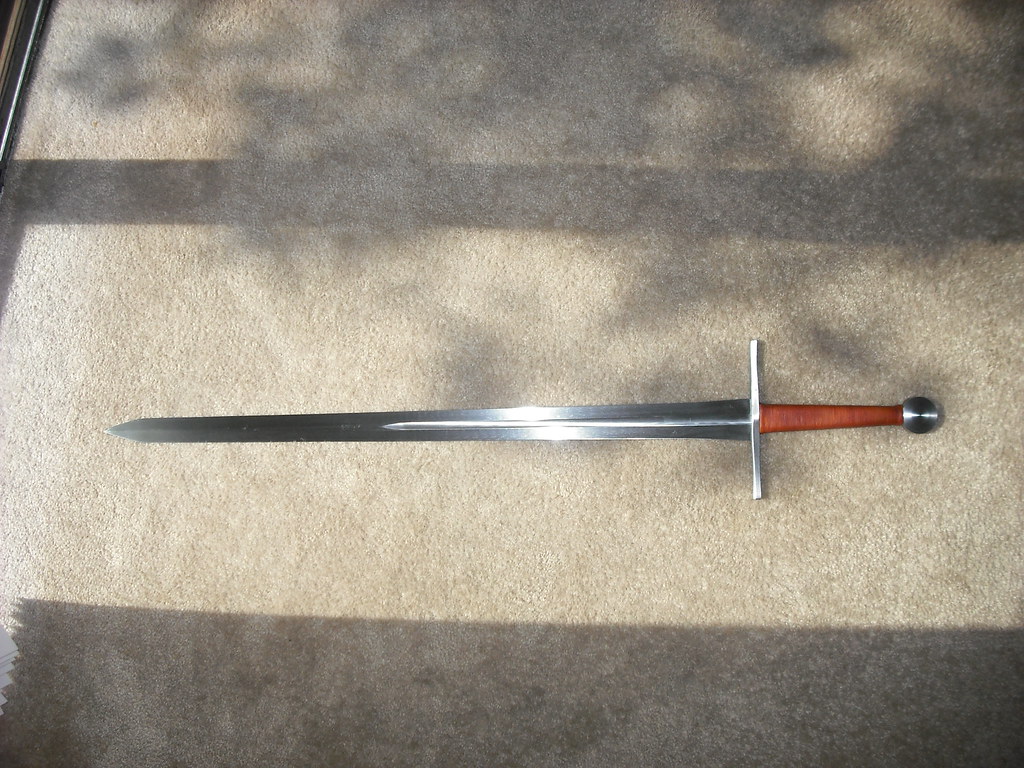
The steel components did have a few uneven grinding marks, but overall the level of polish on the sword was a steady satin, and reflected light evenly.
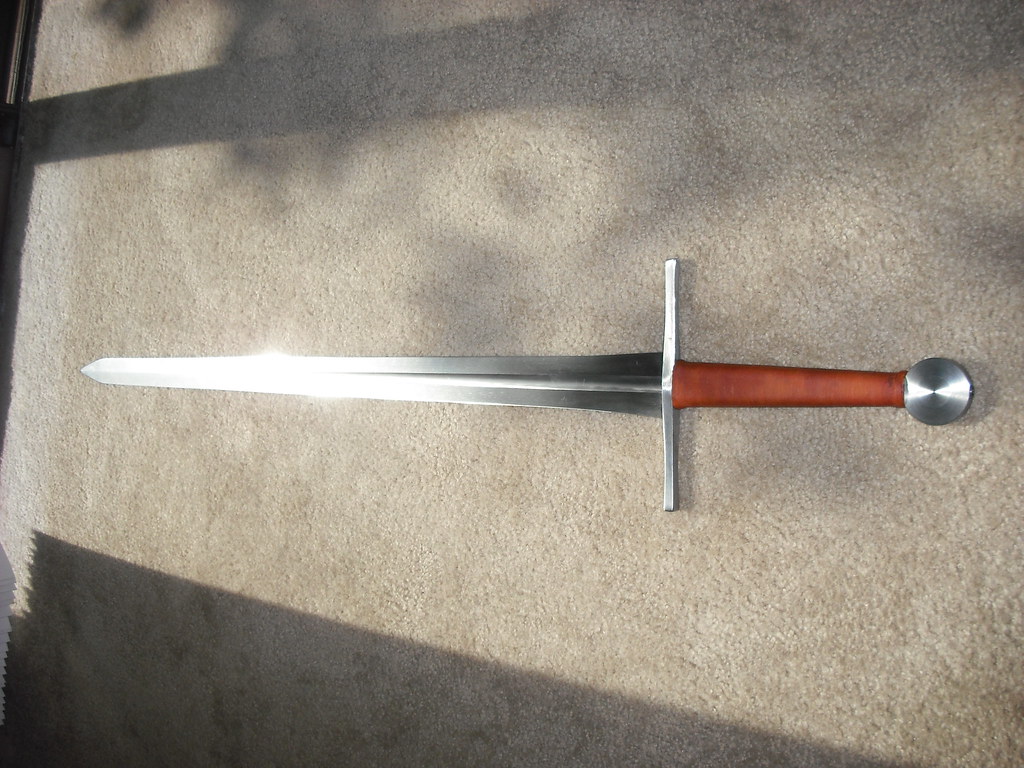

Statistics
Weight: 2lbs, 12oz
Overall Length: 43 1/2"
Blade Length: 34"
Grip Length: 7 1/2"
Crossguard Length: 8 1/4"
POB: 4 1/4"
COP: 21 1/2"
Blade width at guard: 2 1/4"
Blade width at COP: 1 1/2"
Blade width 1" from tip: 3/4"
Blade thickness at guard: 6.1mm
Blade thickness at COP: 3.9mm
Blade thickness 1" from tip: 2.2mm
Cutting sweet spot: 19"-26"
The Blade
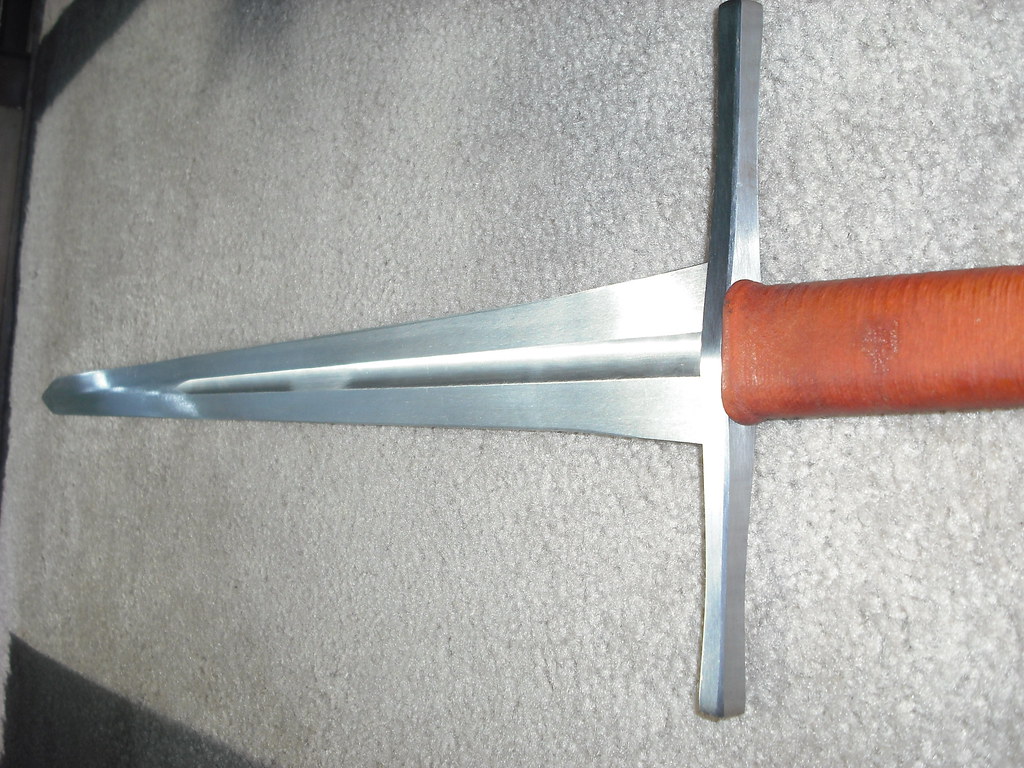
With a strong distal taper of 64% from crossguard to tip, the blade itself balances very nicely near the guard, and is very light and flexible. In keeping with its historical type, it flares slightly near the guard, then tapers very little, maintaining a broad cutting blade before finally coming sharply down to the point at the last few inches.
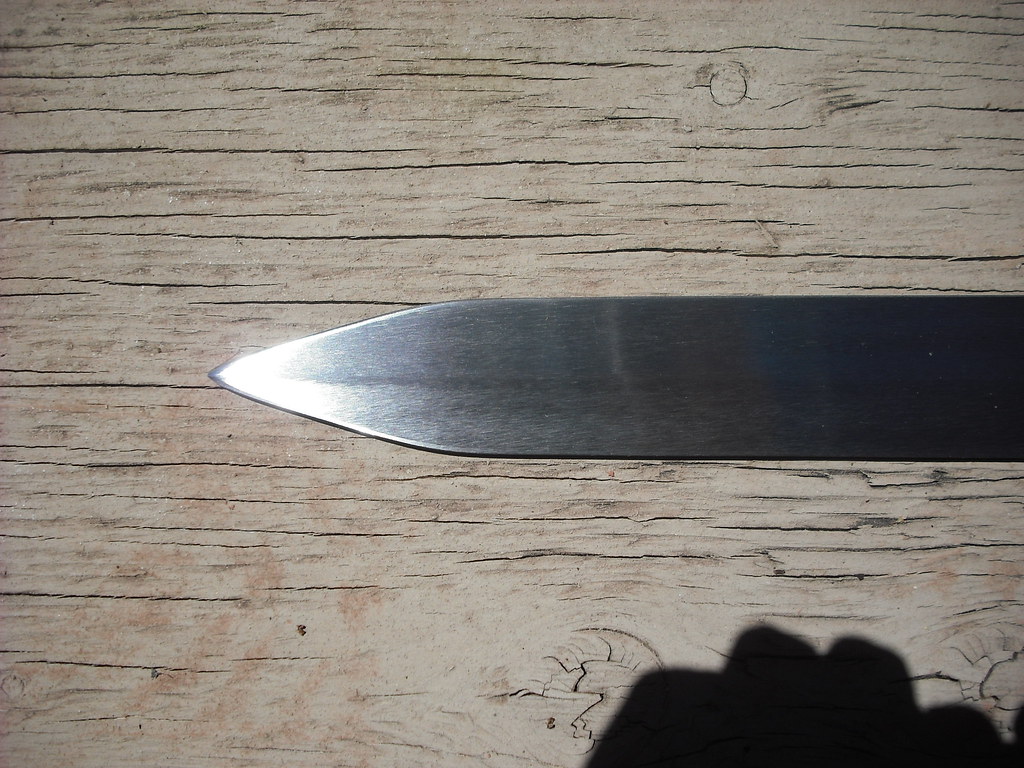
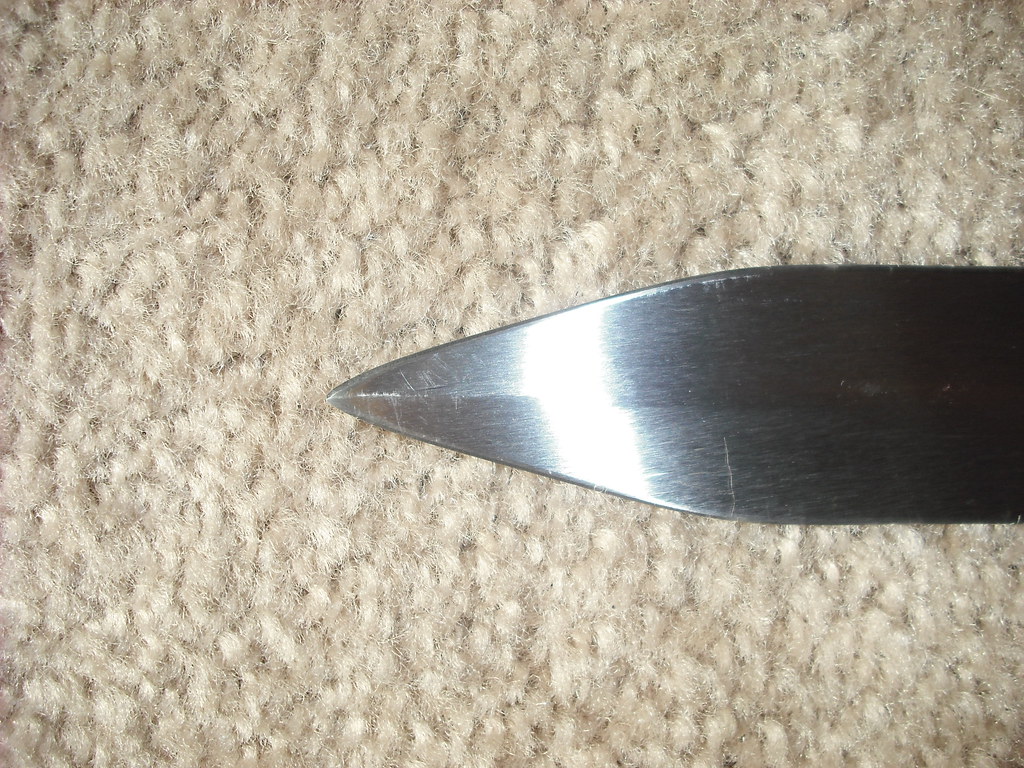
I would have preferred to see a softer, less triangular shape for this blade type, creating more of a rounded tip. However, there are historical examples of tips of this shape, so it is more of a personal preference. I just felt that the sudden corners at the beginning of the point were a bit severe.
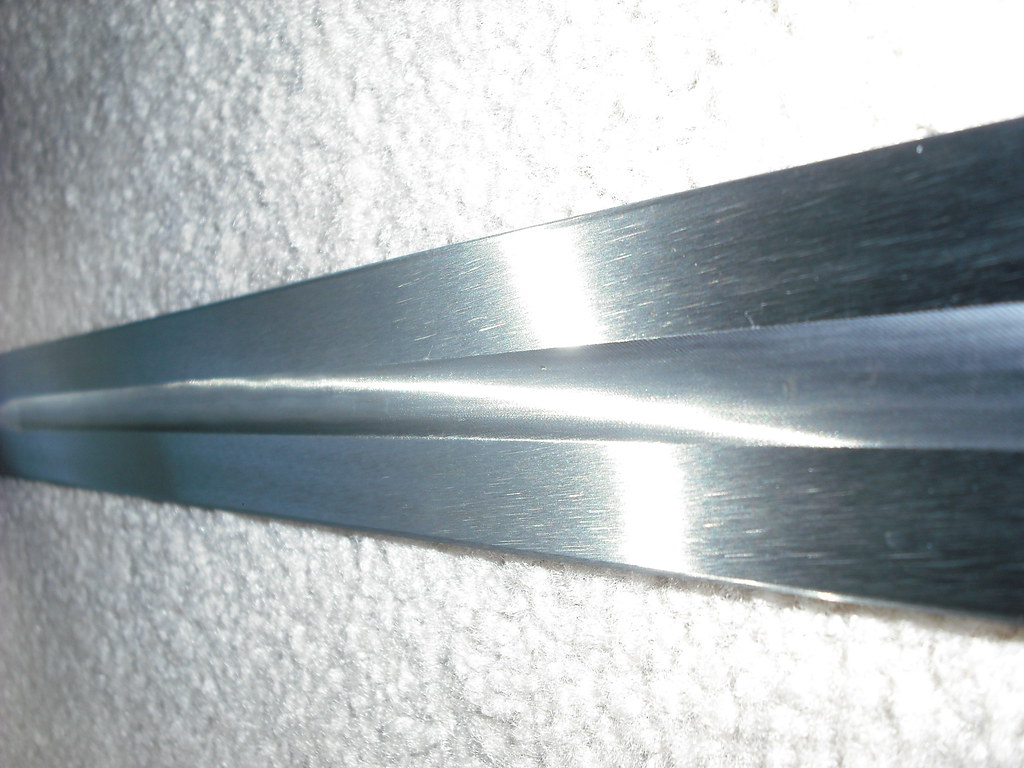
Overall, the blade seemed very well formed. Its fullers were straight and even and terminated uniformly on both sides. One can still see the machining marks that ground out the fuller, but they still provided a nice look.
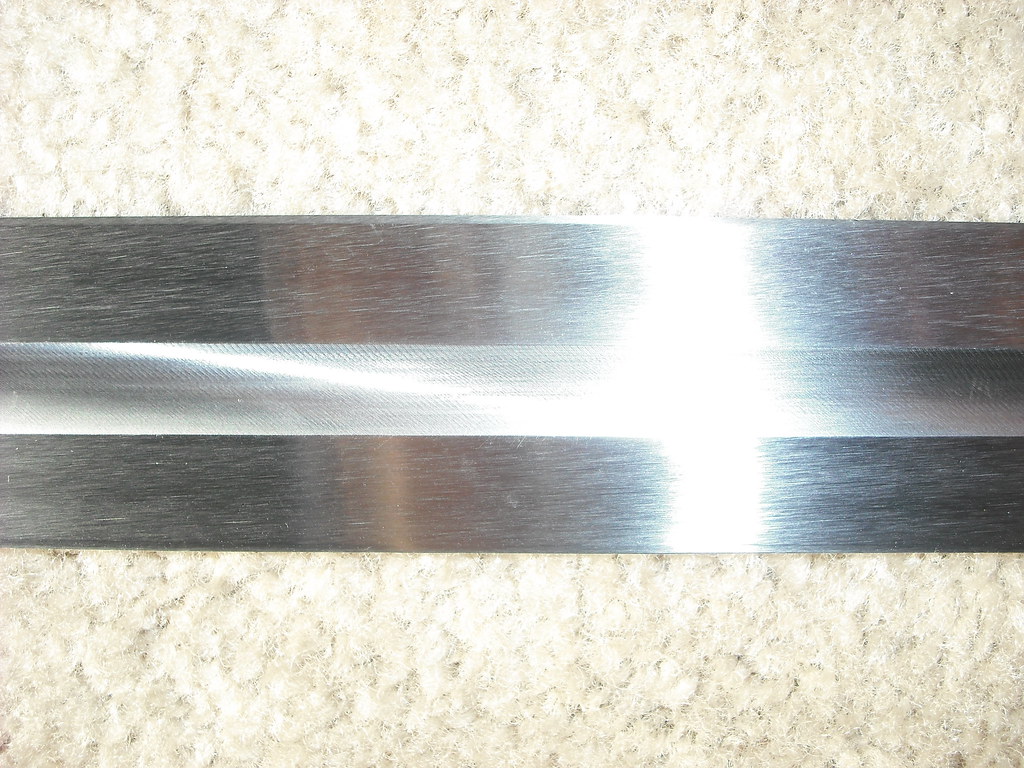
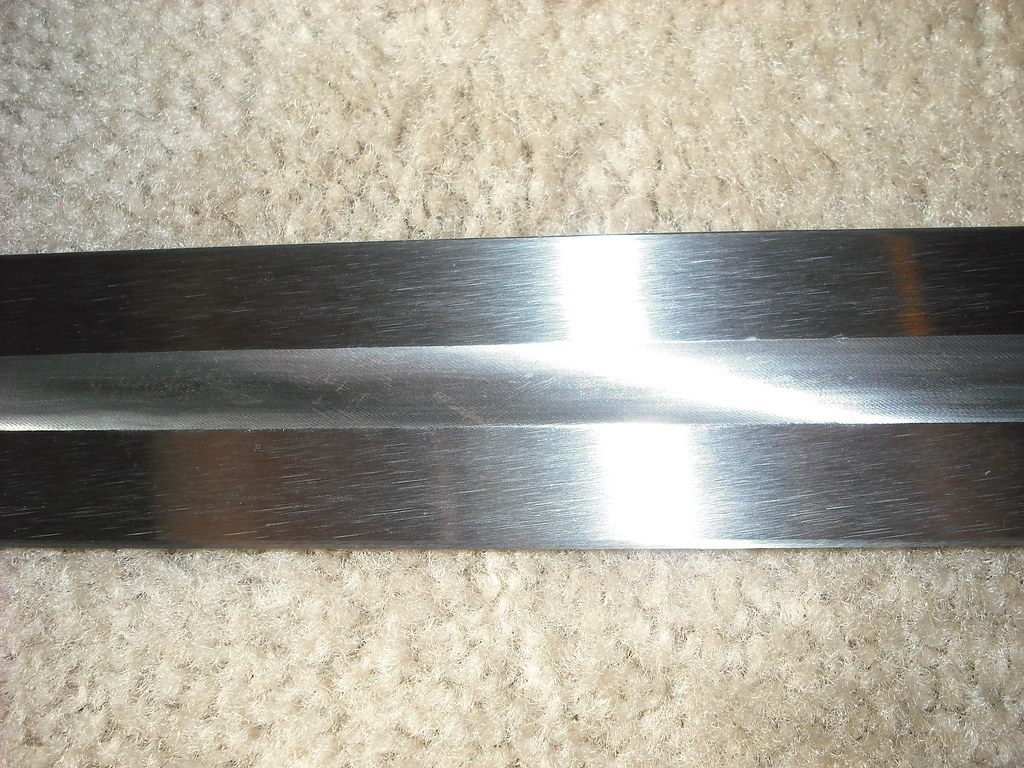
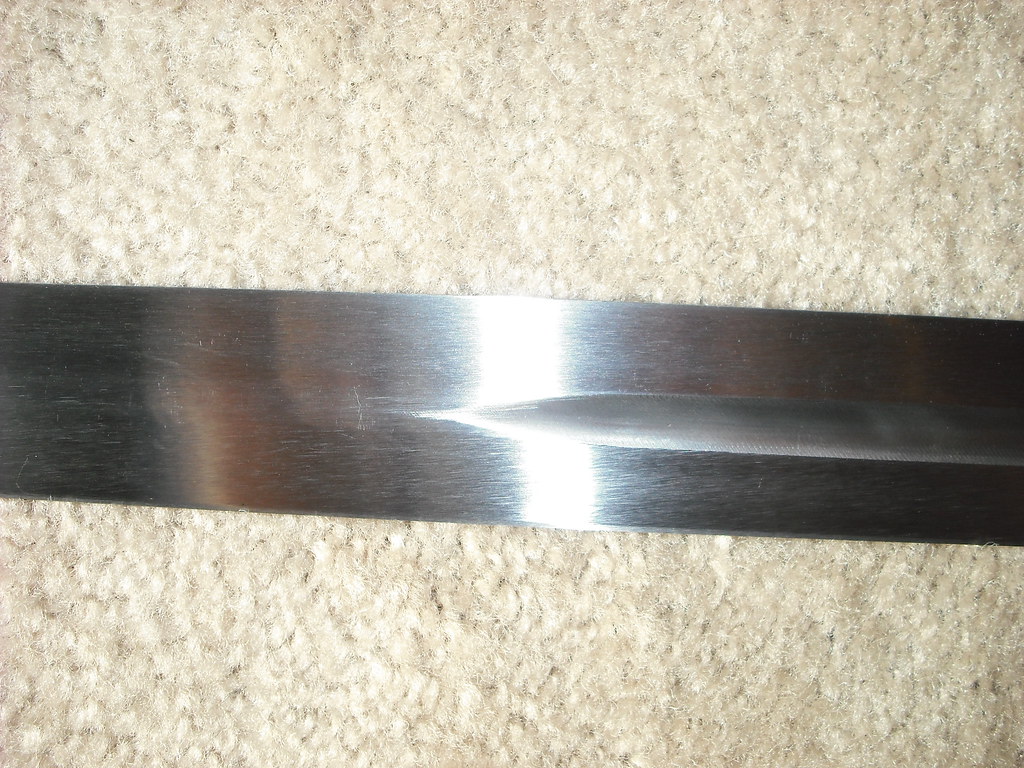
The satin polish was also mostly even, save for a few light scratches several places.
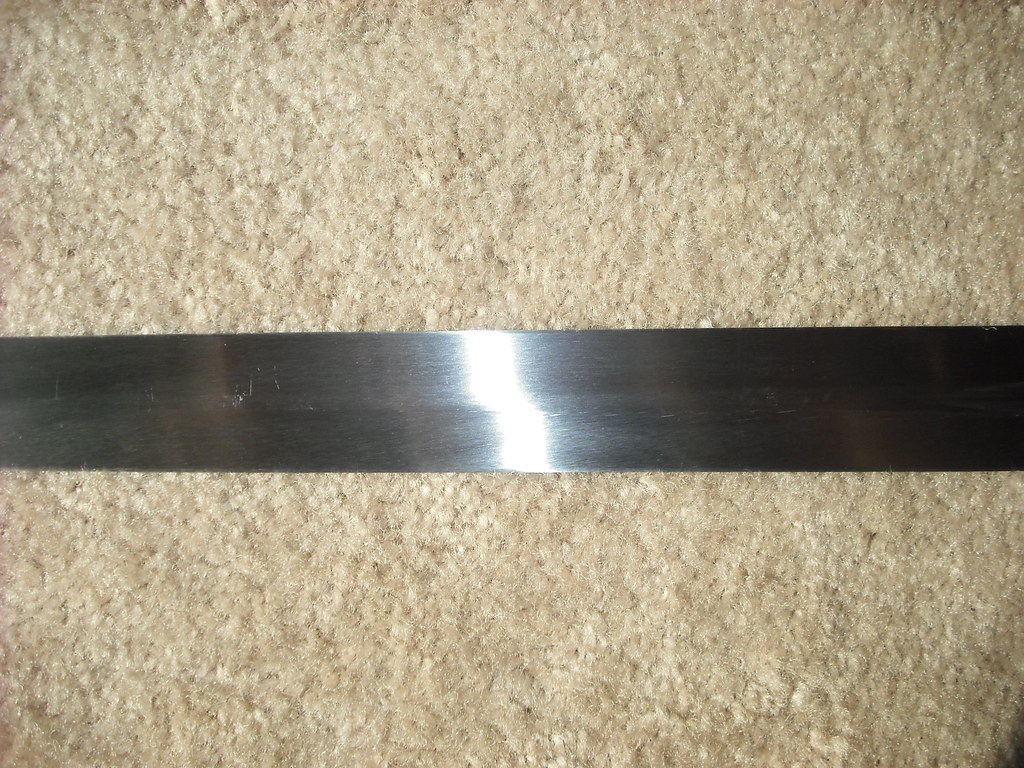
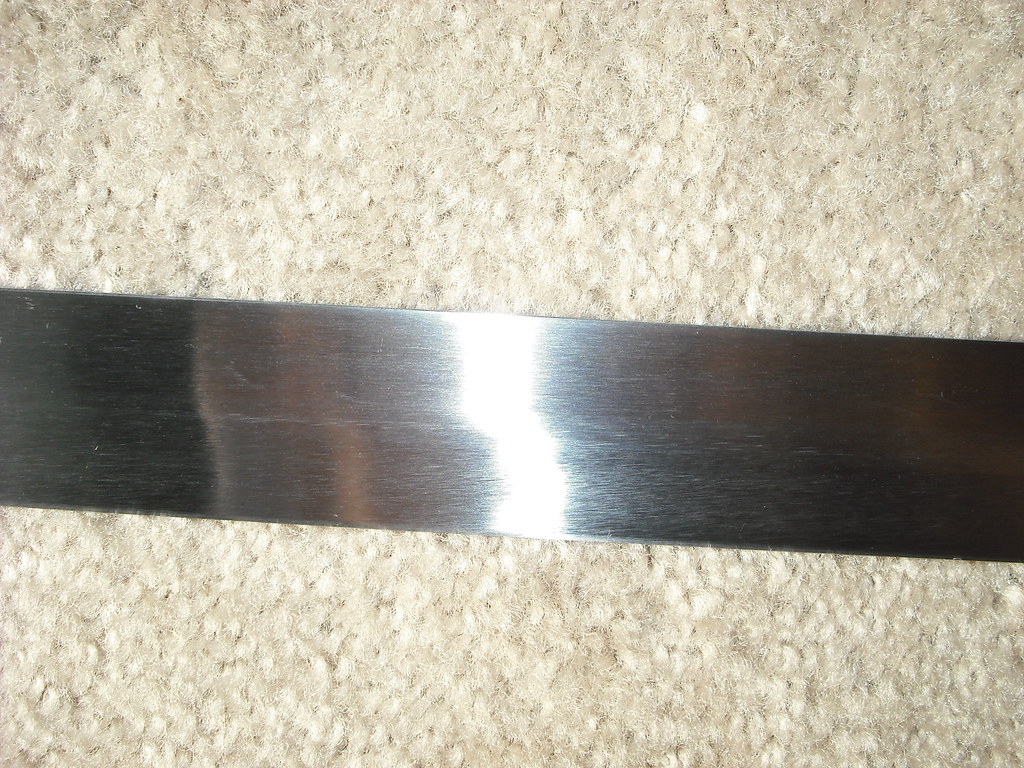
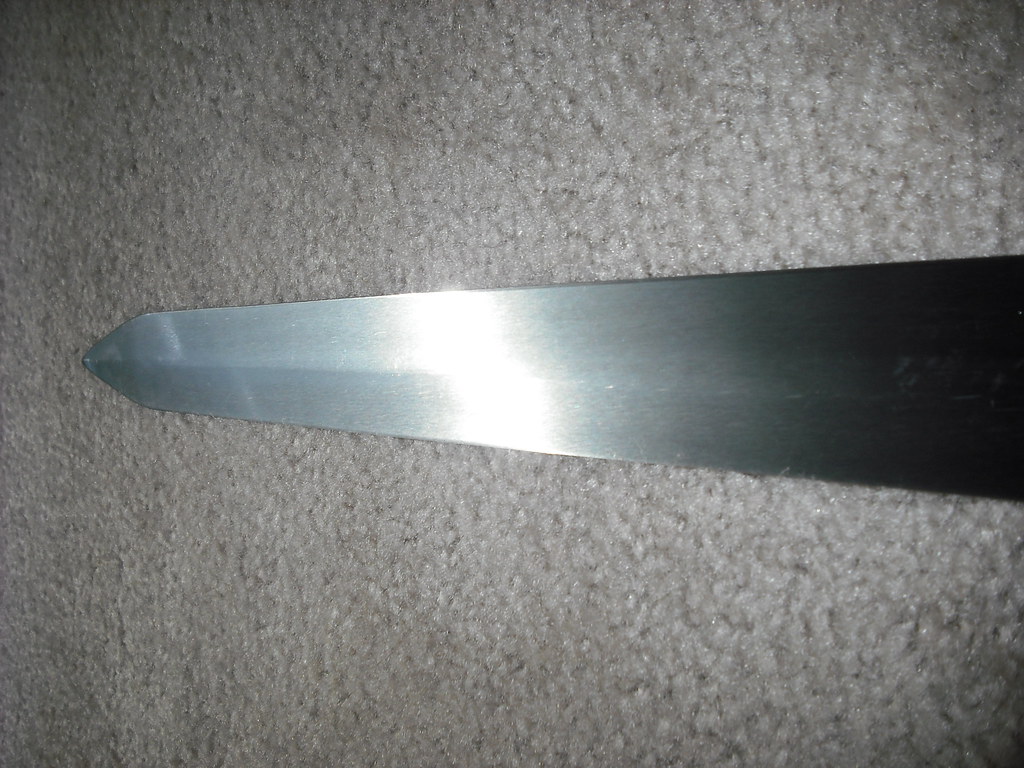

The edge did have a slight secondary bevel, but it was well blended and the edge was still sharp enough to cut paper.
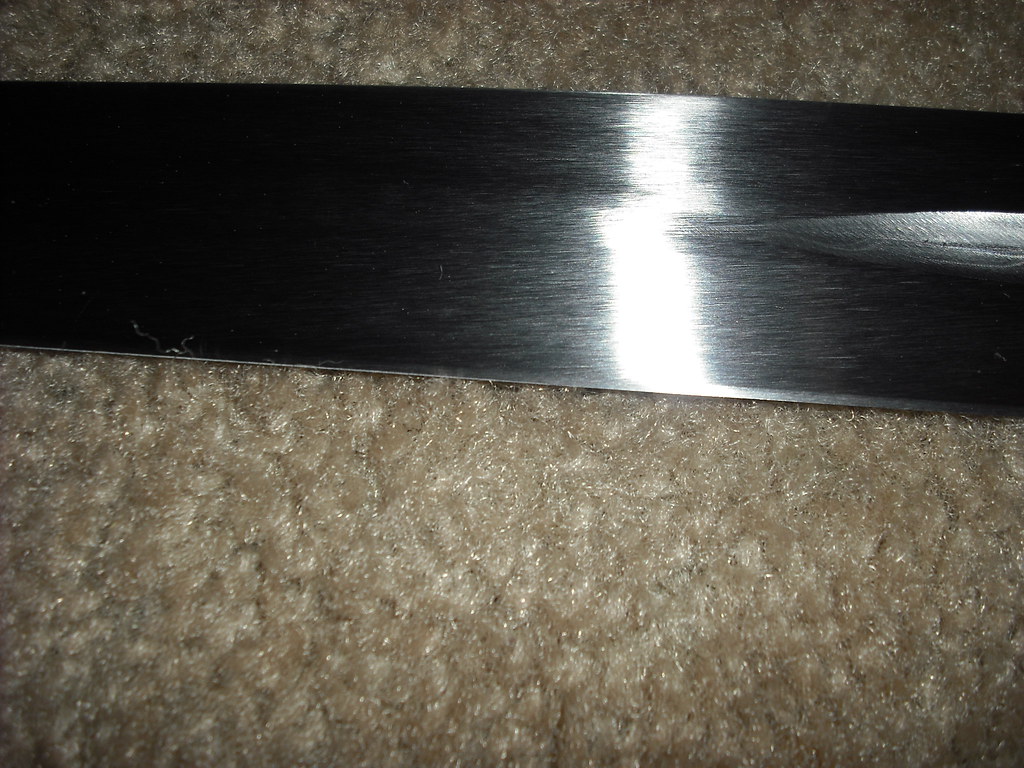

Although the cross-section is lenticular, there is a slight flat face just past the fuller that makes it slightly hexagonal at that point. Just as with the tip, I would have preferred to see a softer geometry there rather than the hard lines.
The Hilt
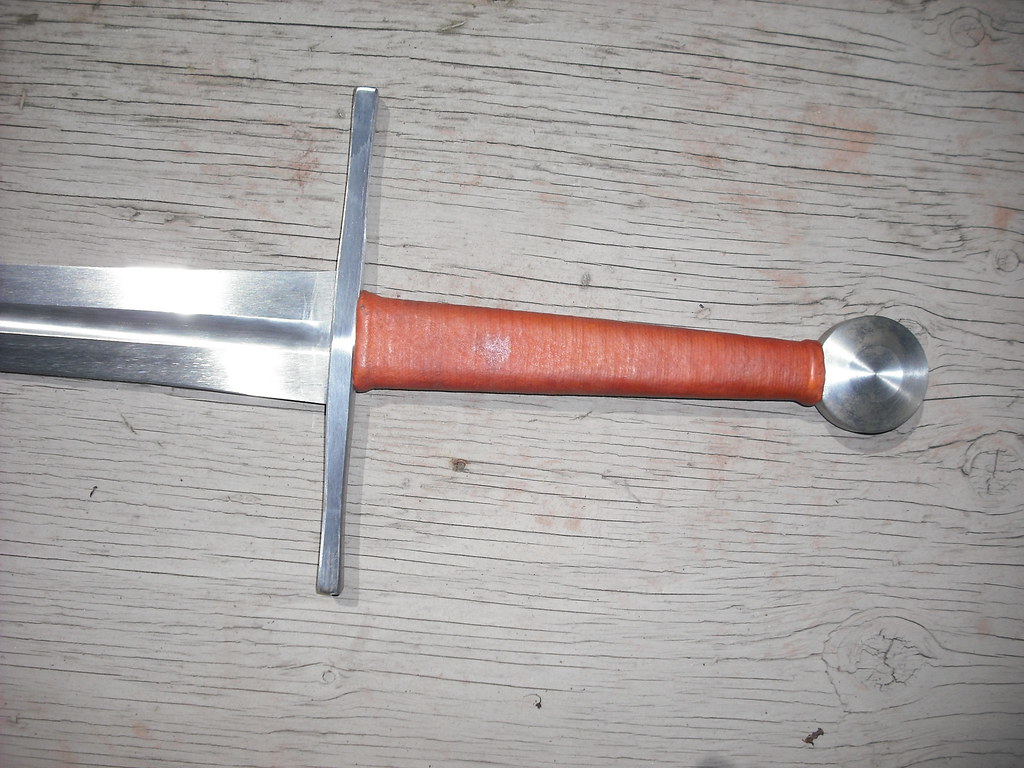
The overall look is simple but clean, and quite attractive. The crossguard looks symmetrical and is slightly waisted in both directions.
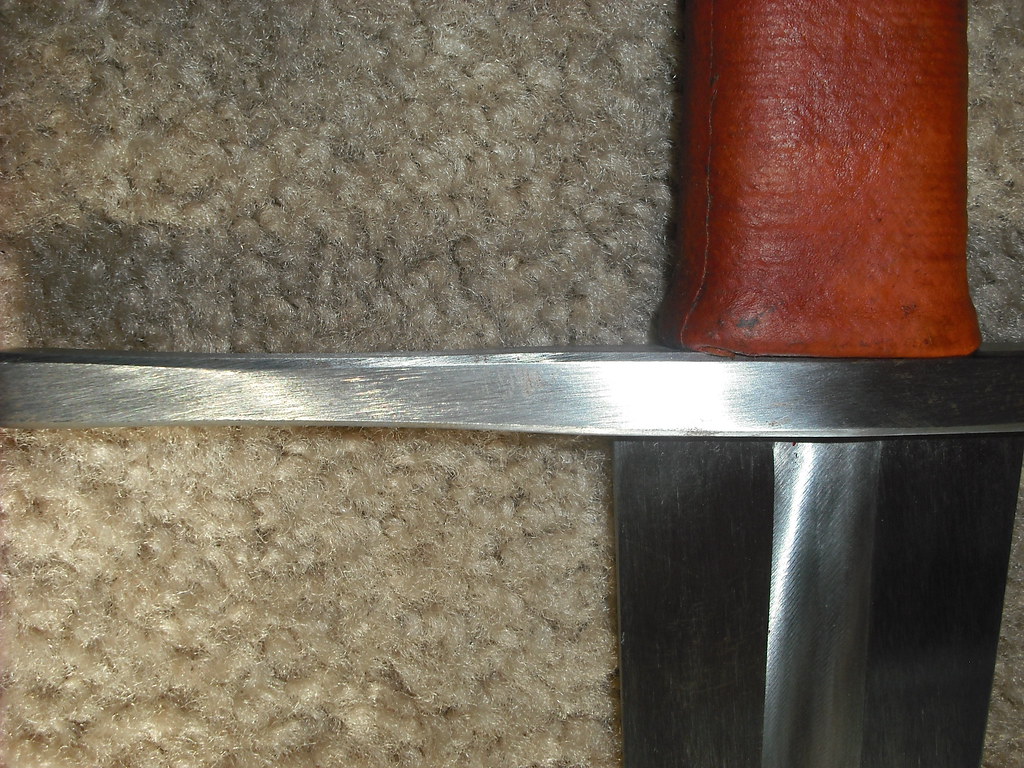
It also interfaces with the blade very nicely and snugly.
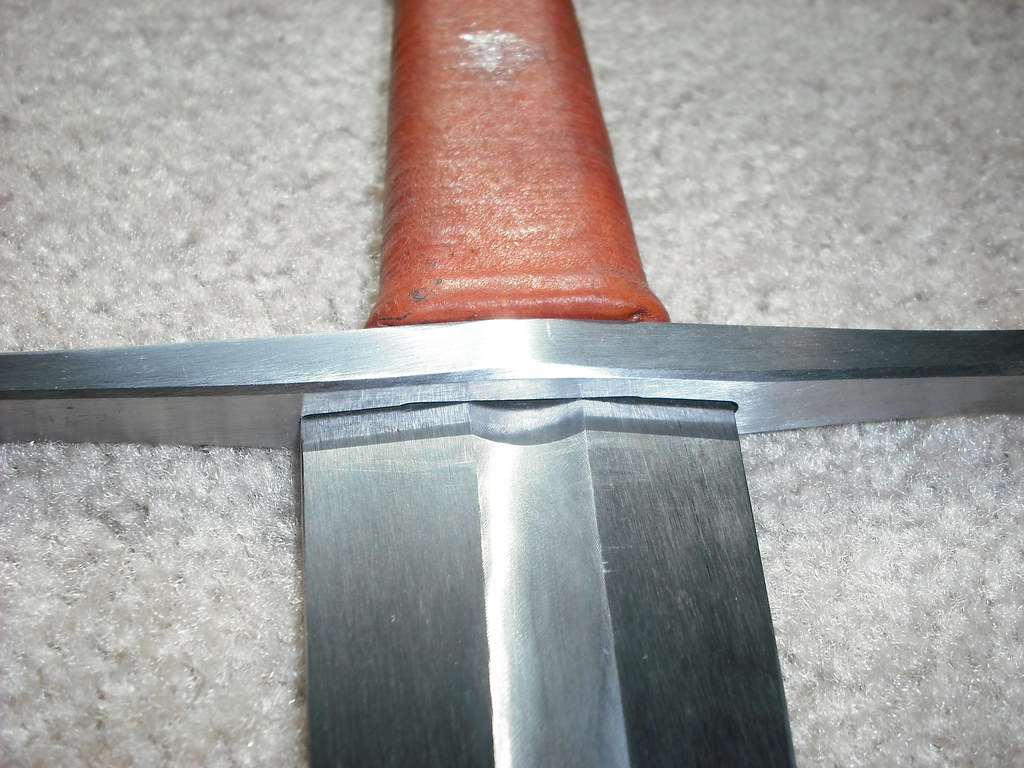
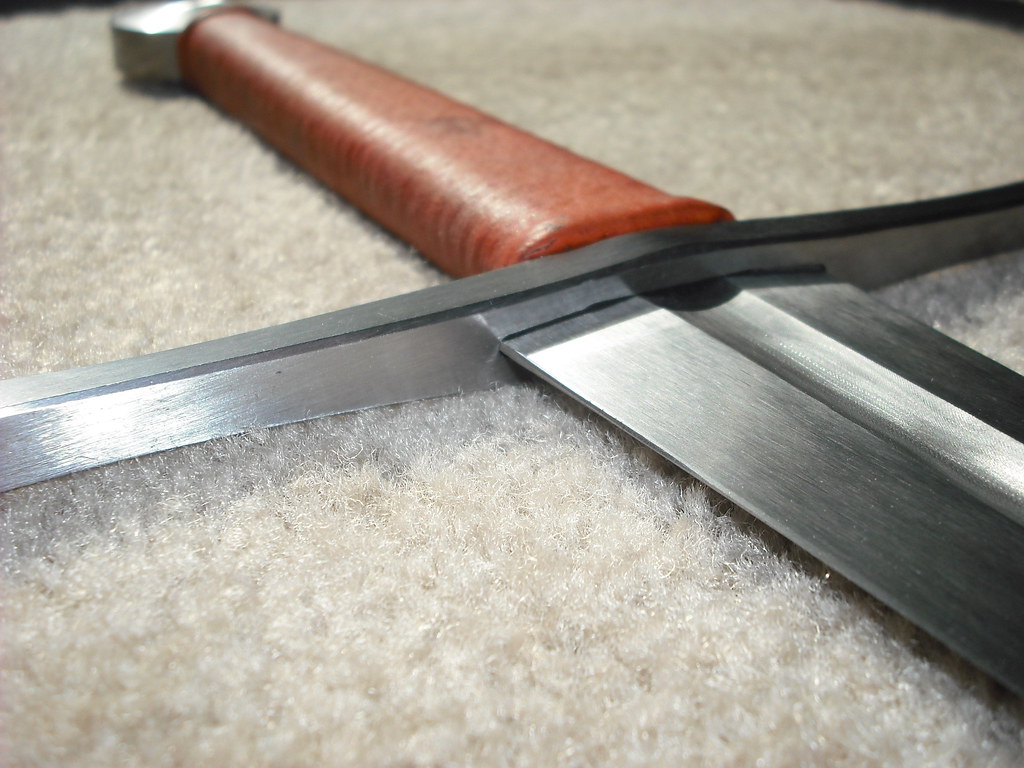
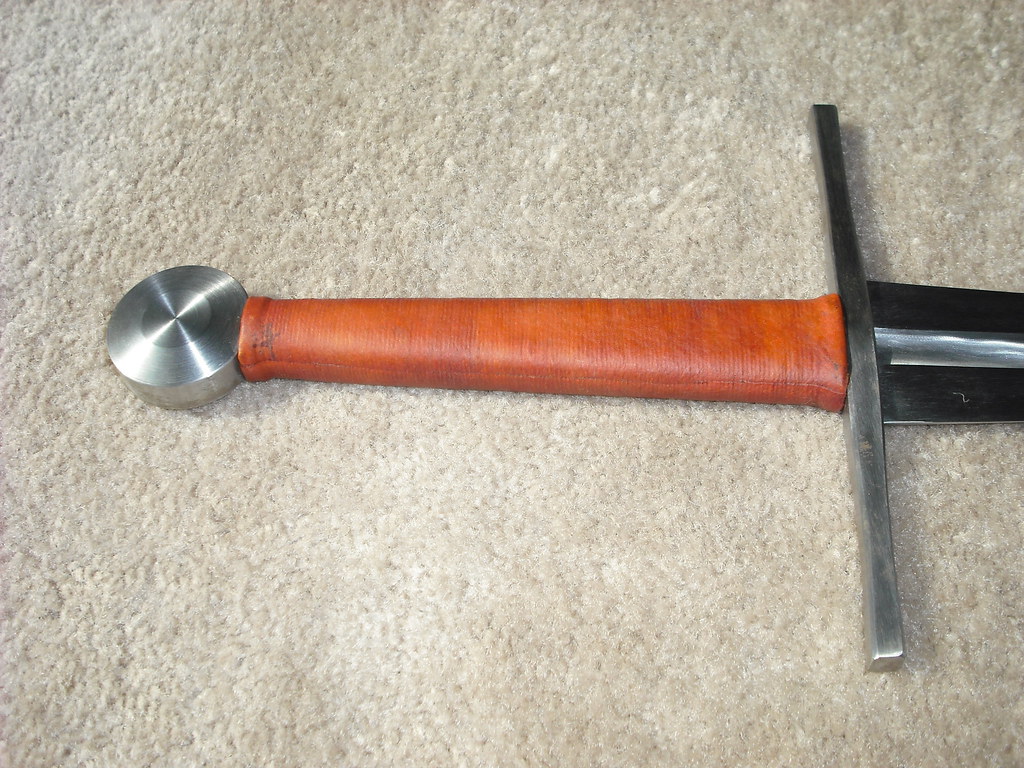
The grip appears to be orange leather wrapped over cord and features a good clean seam.
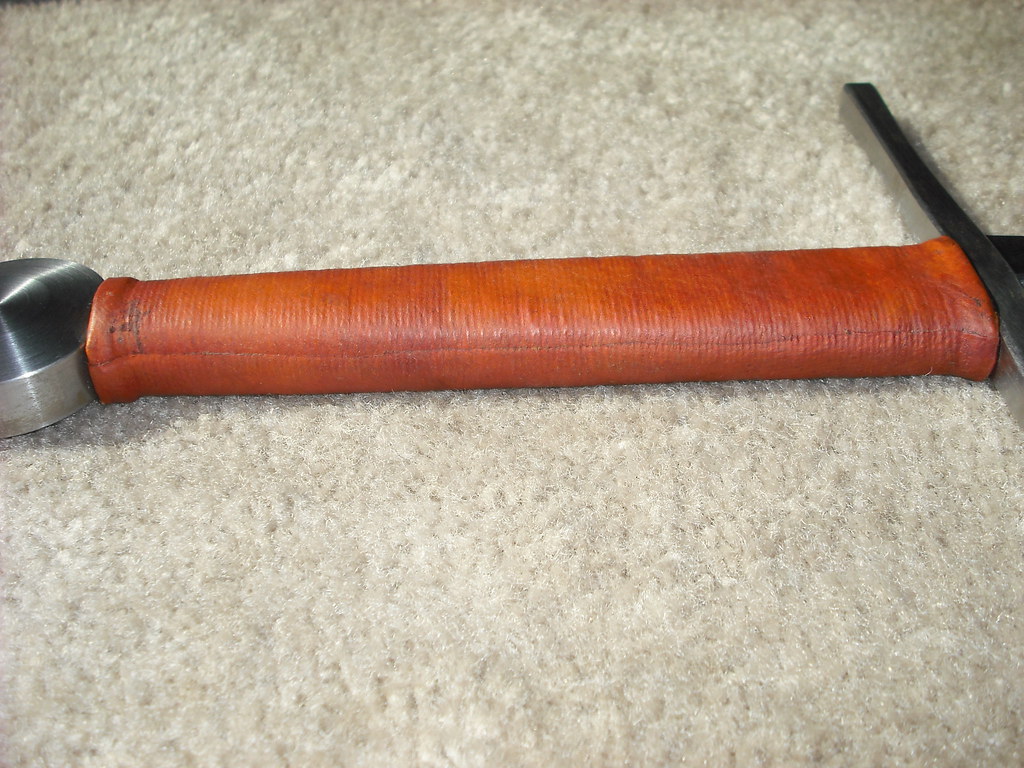
The leatherwork also terminates nicely at both the crossguard and the pommel.
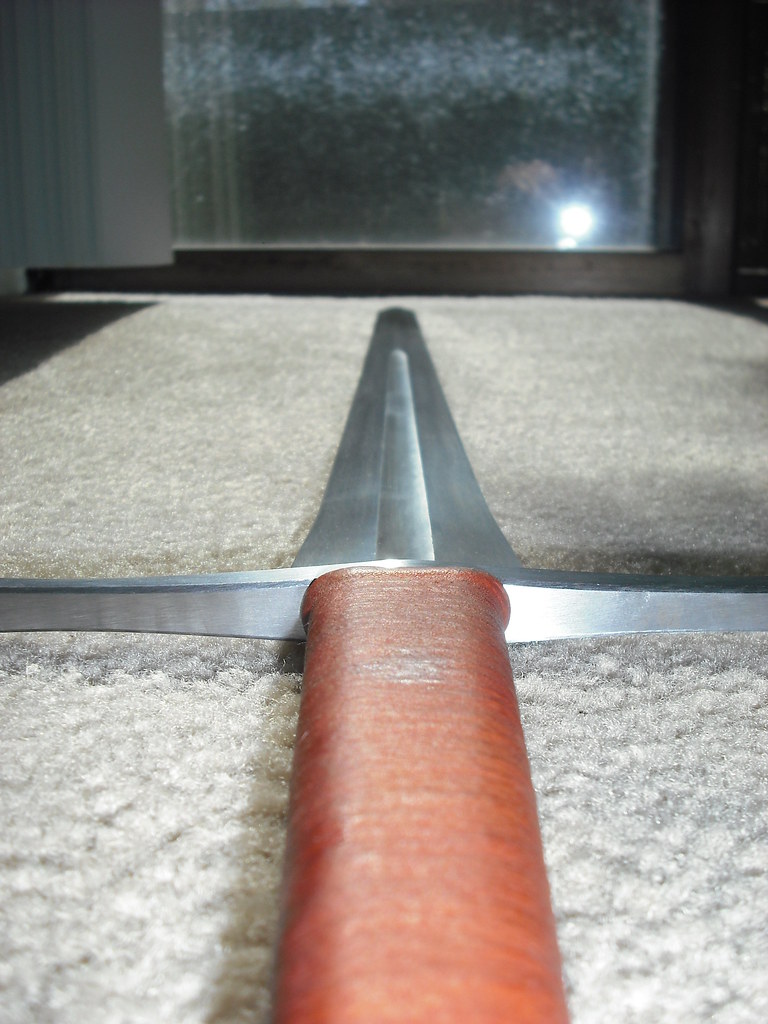
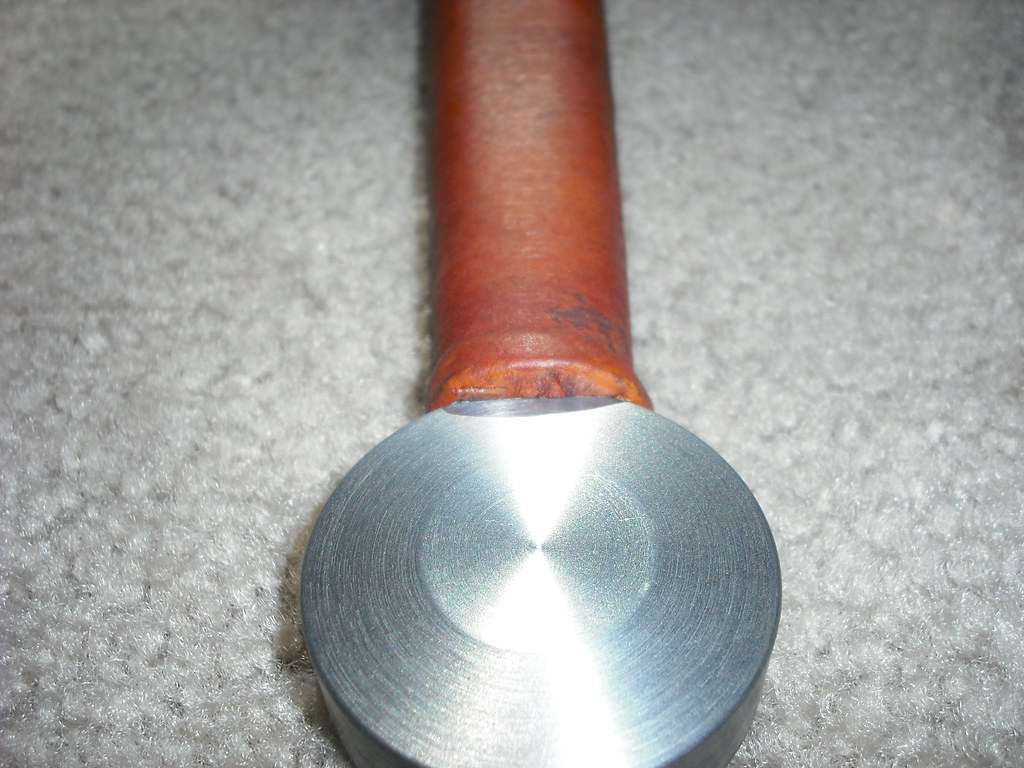
Speaking of the pommel, it is a plain disk (type I?) shape with crisp geometry and is well executed.
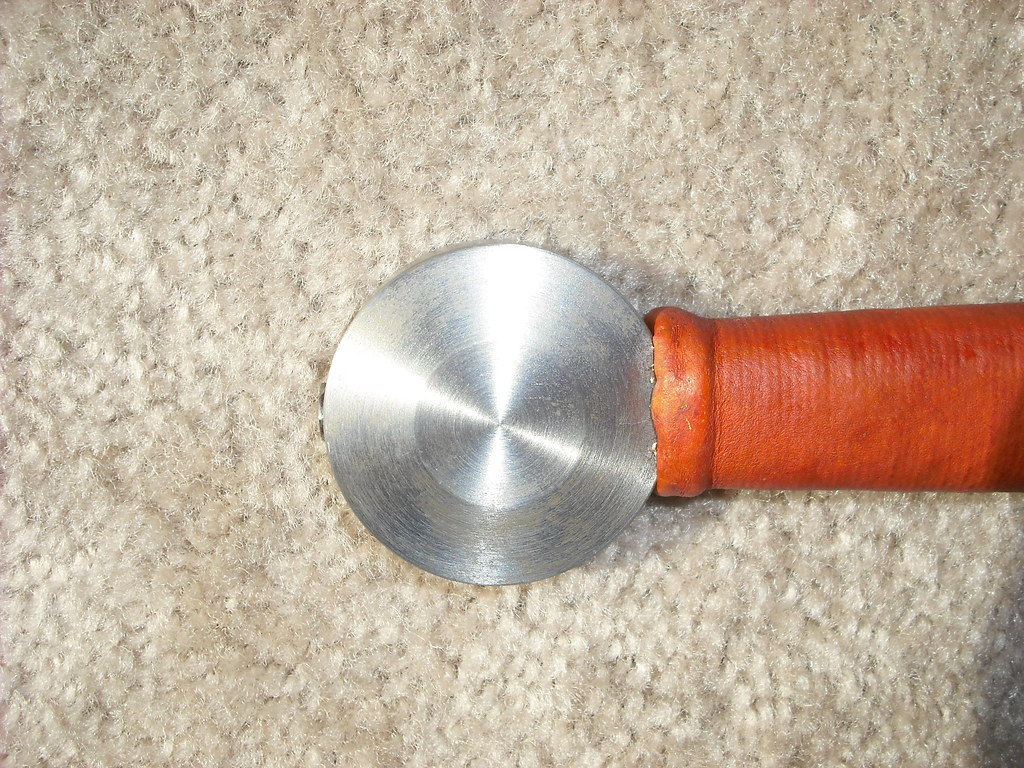
As with most of Gus’ swords, the pommel is secured to the end of the tang with a hex nut for easy disassembly and customization.
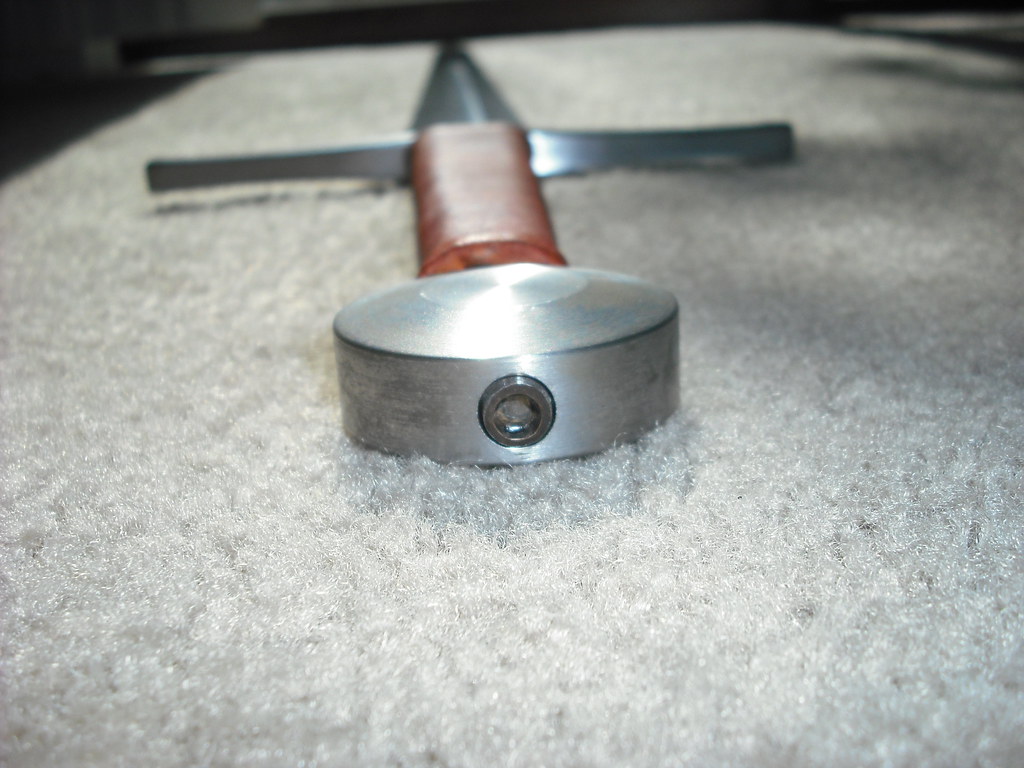
Handling and Testing
When I first lifted the sword, it was immediately obvious to me that this was at the lighter end of the XIIIa spectrum, and I could easily wield it in one hand with no trouble (and although I am 6’ 2” I am by no means a bodybuilder and I myself am on the lighter end of the spectrum). With two hands, it felt weightless and stopped on a dime, which is remarkable given its size. The point also tracks very well when changing guard positions. The other remarkable thing about this sword is its center of percussion. All good swords have a vibrational node on the blade that does not vibrate or bounce when struck against a target. The node on this sword is a good 7 inches long, extending from about 8 inches behind the point to the top of the fuller. It says a lot about the harmonics that Gus puts into his swords, as I have heard similar stories about several of his other swords.
And now for the moment you’ve all been waiting for; the TL;DR of all sword reviews: the cutting video! Yes I cut a vegetable with it. I also don’t believe in wasting food, so I ate the green pepper afterward after washing it. I also got to cut tatami with it at Tom’s place.
As expected, the sword sailed through the tatami like it wasn’t there, and it was sharp enough to slice that green pepper multiple times without disturbing the bottom portion.
Conclusions
I honestly had to nitpick on some pretty small details such as a few scratches and points in the geometry to find any fault with this sword. Some buyers may not like the slightly lower level of polish and plain fittings, but what really matters is that the polish is even and the fittings are tight and you can pretty much forget about QC issues. Additionally, when you consider the price point, you are getting a sword that performs just as well as any high end Albion for a price rivaling medium-range production swords. And it is this top of the line performance that should be most important to any user. I was definitely impressed with this sword and would love to handle more of Gus’ swords in the future.
Pros
• Absolutely stunning top-class handling and cutting performance.
• Nothing else comes even remotely close to the above statement at this price point, and few come close at any price.
Cons
• Minor surface scratches and scuffs
• Somewhat blocky geometry in several places
The Bottom Line
Again, the fit and finish is a bit plainer than some higher priced swords, including other ATrim blades featured in higher end products such as Christian Fletcher’s old Chimera line, but Tom and Hiroshi, in founding this line through Tried and True Armory, have created something special here by offering the exact same performance that customers have come to expect from fancier ATrim swords at a price that is just a bit higher than most lower end production swords. I would definitely recommend this sword to others.
By Walter Robins

Introduction
Wow, where do I begin…
A couple weeks ago I was just minding my own business when I suddenly received notification of a PM in my inbox. It was Tom, asking me if I would review and cut with a new sword that Angus Trim had just sent over for Tried and True Armory. After carefully considering the offer for all of 0.00000001 seconds, I decided to take him up on it.
Ok, I know I’m not fooling anyone. I was absolutely jumping up and down with the excitement of getting to handle an ATrim in person. I had only seen pictures and videos of Gus’ swords, wishing I could pick one up. But now, I finally got the chance. I don’t know what prompted Tom to pick me of all people, since I haven’t been terribly active lately in either the forum or my own website, but I’m sure not going to complain about an opportunity like this!
Historical overview
This sword classifies as an Oakeshott type XIIIa. The type XIII swords are similar to the more classically represented type XII swords, but exhibit far less profile taper (thus an overall broader blade) and a more rounded tip, favoring the cut, whereas the type XII seeks a balance between cutting and thrusting. In relation to the plain vanilla type, the XIIIa is similar to the XIIa in that it sports a larger blade and a longer handle than the type XIII, allowing for comfortable two-handed use.
If I had to guess on the fittings based on my limited knowledge of fittings typology, I would say the crossguard is a style 1, while the pommel appears to be a type I.
Full Disclosure
I do not actually own this sword, and thus did not pay anything for it. It was sent to me by Tom on behalf of Tried and True Armory for review. It was thus essentially a free review sword. However, after having met Tom and Gus in person, I feel strongly that they are upstanding individuals who would want me to call it like it is and not to pull any punches in the review; so I will do just so.
It should also be noted here that although I was offered this sword to review, I am not receiving any compensation or free products to keep as a result of this review, so I have no financial incentives to be biased in any given direction. I do, however, have every reason to pursue respect and trustworthiness in the sword community, and so I will definitely do my best to be impartial here.
Initial Impressions
This sword came packed in a simple cardboard sheath. While thin, it did not show any signs of damage during shipping. After quickly removing the cardboard, I was presented with the sword itself.

The steel components did have a few uneven grinding marks, but overall the level of polish on the sword was a steady satin, and reflected light evenly.


Statistics
Weight: 2lbs, 12oz
Overall Length: 43 1/2"
Blade Length: 34"
Grip Length: 7 1/2"
Crossguard Length: 8 1/4"
POB: 4 1/4"
COP: 21 1/2"
Blade width at guard: 2 1/4"
Blade width at COP: 1 1/2"
Blade width 1" from tip: 3/4"
Blade thickness at guard: 6.1mm
Blade thickness at COP: 3.9mm
Blade thickness 1" from tip: 2.2mm
Cutting sweet spot: 19"-26"
The Blade

With a strong distal taper of 64% from crossguard to tip, the blade itself balances very nicely near the guard, and is very light and flexible. In keeping with its historical type, it flares slightly near the guard, then tapers very little, maintaining a broad cutting blade before finally coming sharply down to the point at the last few inches.


I would have preferred to see a softer, less triangular shape for this blade type, creating more of a rounded tip. However, there are historical examples of tips of this shape, so it is more of a personal preference. I just felt that the sudden corners at the beginning of the point were a bit severe.

Overall, the blade seemed very well formed. Its fullers were straight and even and terminated uniformly on both sides. One can still see the machining marks that ground out the fuller, but they still provided a nice look.



The satin polish was also mostly even, save for a few light scratches several places.




The edge did have a slight secondary bevel, but it was well blended and the edge was still sharp enough to cut paper.


Although the cross-section is lenticular, there is a slight flat face just past the fuller that makes it slightly hexagonal at that point. Just as with the tip, I would have preferred to see a softer geometry there rather than the hard lines.
The Hilt

The overall look is simple but clean, and quite attractive. The crossguard looks symmetrical and is slightly waisted in both directions.

It also interfaces with the blade very nicely and snugly.



The grip appears to be orange leather wrapped over cord and features a good clean seam.

The leatherwork also terminates nicely at both the crossguard and the pommel.


Speaking of the pommel, it is a plain disk (type I?) shape with crisp geometry and is well executed.

As with most of Gus’ swords, the pommel is secured to the end of the tang with a hex nut for easy disassembly and customization.

Handling and Testing
When I first lifted the sword, it was immediately obvious to me that this was at the lighter end of the XIIIa spectrum, and I could easily wield it in one hand with no trouble (and although I am 6’ 2” I am by no means a bodybuilder and I myself am on the lighter end of the spectrum). With two hands, it felt weightless and stopped on a dime, which is remarkable given its size. The point also tracks very well when changing guard positions. The other remarkable thing about this sword is its center of percussion. All good swords have a vibrational node on the blade that does not vibrate or bounce when struck against a target. The node on this sword is a good 7 inches long, extending from about 8 inches behind the point to the top of the fuller. It says a lot about the harmonics that Gus puts into his swords, as I have heard similar stories about several of his other swords.
And now for the moment you’ve all been waiting for; the TL;DR of all sword reviews: the cutting video! Yes I cut a vegetable with it. I also don’t believe in wasting food, so I ate the green pepper afterward after washing it. I also got to cut tatami with it at Tom’s place.
As expected, the sword sailed through the tatami like it wasn’t there, and it was sharp enough to slice that green pepper multiple times without disturbing the bottom portion.
Conclusions
I honestly had to nitpick on some pretty small details such as a few scratches and points in the geometry to find any fault with this sword. Some buyers may not like the slightly lower level of polish and plain fittings, but what really matters is that the polish is even and the fittings are tight and you can pretty much forget about QC issues. Additionally, when you consider the price point, you are getting a sword that performs just as well as any high end Albion for a price rivaling medium-range production swords. And it is this top of the line performance that should be most important to any user. I was definitely impressed with this sword and would love to handle more of Gus’ swords in the future.
Pros
• Absolutely stunning top-class handling and cutting performance.
• Nothing else comes even remotely close to the above statement at this price point, and few come close at any price.
Cons
• Minor surface scratches and scuffs
• Somewhat blocky geometry in several places
The Bottom Line
Again, the fit and finish is a bit plainer than some higher priced swords, including other ATrim blades featured in higher end products such as Christian Fletcher’s old Chimera line, but Tom and Hiroshi, in founding this line through Tried and True Armory, have created something special here by offering the exact same performance that customers have come to expect from fancier ATrim swords at a price that is just a bit higher than most lower end production swords. I would definitely recommend this sword to others.








